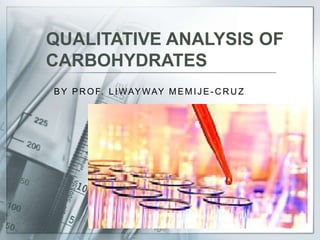
Qualitative analysis of carbohydrates
- 1. BY PR OF. LIWAYWAY MEMIJ E - C R U Z QUALITATIVE ANALYSIS OF CARBOHYDRATES
- 2. WHAT ARE CARBOHYDRATES? most abundant organic compounds found in living organisms and are composed of carbon, hydrogen and oxygen. act as the primary source to provide energy for functioning of living organisms. are called carbohydrates because they can be considered as hydrates of carbon have the general formula Cx(H2O)y Carbohydrates are called saccharides. Some of them have sweet taste and are called sugars.
- 3. HOW DO YOU CLASSIFY CARBOHYDRATES BASED ON REACTIVITY? Based on the reactivity with several laboratory tests, carbohydrates are classified as; 1. Reducing sugars Carbohydrates that can reduce Tollen’s, Benedict’s or Fehling’s reagents are called reducing sugars (sugar with free aldehyde or ketone group). All monosaccharides and most of the disaccharides are reducing sugars. Some examples are Maltose and Lactose. 2. Non-reducing sugars Carbohydrates that cannot reduce Tollen’s, Benedict’s or Fehling’s reagents are called non-reducing sugars. Sucrose is a non-reducing sugar.
- 4. THEORY 1. Carbohydrates are polyhydroxy aldehydes and ketones or substances that hydrolyze to yield polyhydroxy aldehydes and ketones. Aldehydes (–CHO) and ketones ( = CO) constitute the major groups in carbohydrates. 2. Carbohydrates are mainly divided into monosaccharides, disaccharides and polysaccharides. The commonly occurring monosaccharides includes glucose, fructose, galactose, ribose, etc. The two monosaccharides combine together to form disaccharides which include sucrose, lactose and maltose. Starch and cellulose fall into the category of polysaccharides, which consist of many monosaccharide residues.
- 5. MOLISCH’S TEST: • Molisch’s reagent is 10% alcoholic solution of α- naphthol. This is a common chemical test to detect the presence of carbohydrates. Carbohydrates undergo dehydration by sulphuric acid to form furfural (furfuraldehyde) that reacts with α-naphthol to form a violet colored product
- 6. FEHLING’S TEST This forms the reduction test of carbohydrates. Fehling’s solution contains blue alkaline cupric hydroxide solution, heated with reducing sugars gets reduced to yellow or red cuprous oxide and is precipitated. Hence, formation of the yellow or brownish-red colored precipitate helps in the detection of reducing sugars in the test solution.
- 7. BENEDICT’S TEST • Benedict’s test distinguishes reducing sugar from non- reducing sugar. • Benedict’s reagent contains blue copper (II) ions (Cu2+, cupric ions) that are reduced to copper (I) ions (Cu+, cuprous ions) by carbohydrates. These ions form precipitate as red colored cuprous (copper (I) oxide.
- 8. BARFOED’S TEST Used to detect the presence of monosaccharide (reducing) sugars in solution. Barfoed's reagent, a mixture of ethanoic (acetic) acid and copper(II) acetate, is combined with the test solution and boiled. A red copper(II) oxide precipitate is formed will indicates the presence of reducing sugar. The reaction will be negative in the presence of disaccharide sugars because they are weaker reducing agents. This test is specific for monosaccharides . Due to the weakly acidic nature of Barfoed's reagent, it is reduced only by monosaccharides.
- 9. SELIWANOFF’S TEST: It is a color reaction specific for ketoses. When conce: HCl is added. ketoses undergo dehydration to yield furfural derivatives more rapidly than aldoses. These derivatives form complexes with resorcinol to yield deep red color. The test reagent causes the dehydration of ketohexoses to form 5- hydroxymethylfurfural. 5- hydroxymethylfurfural reacts with resorcinol present in the test reagent to produce a red product within two minutes (reaction not shown). Aldohexoses reacts so more slowly to form the same product.
- 10. BIAL’S TEST Bial’s test is used to distinguish between pentoses and hexoses. They react with Bial’s reagent and are converted to furfural. Orcinol and furfural condense in the presence of ferric ion to form a colored product. Appearance of green colour or precipitate indicates the presence of pentoses and formation of muddy brown precipitate shows the presence of hexoses.
- 11. NYLANDER'S TEST It is a chemical test used for detecting the presence of reducing sugars. When Nylander's reagent, which consists of bismuth nitrate, potassium sodium tartrate and potassium hydroxide, is added to a solution with reducing sugars, a black precipitate of metallic bismuth is formed.
- 12. IODINE TEST Iodine test is used to detect the presence of starch. Iodine is not much soluble in water so iodine solution is prepared by dissolving iodine in water in presence of potassium iodide. Iodine dissolved in an aqueous solution of potassium iodide reacts with starch to form a starch/iodine complex which gives characteristics blue black color to the reaction mixture.
- 13. OSAZONE TEST The ketoses and aldoses react with phenylhydrazine to produce a phenylhydrazone which further reacts with another two molecules of phenylhydrazine to yield osazone. Needle-shaped yellow osazone crystals are produced by glucose, fructose and mannose, whereas lactosazone produces mushroom shaped crystals. Crystals of different shapes will be shown by different osazones. Flower-shaped crystals are produced by maltose.
- 14. REFERENCES • http://vlab.amrita.edu/?sub=3&brch=63&sim=631&cnt=1 • https://www.slideshare.net/namarta28/qualitative-tests- for-carbohydrates-35884145 • https://biochemistryisagoodthing.wordpress.com/2013/02 /17/lab-review-1/ • http://amrita.olabs.edu.in/?sub=73&brch=8&sim=209&cn t=1
